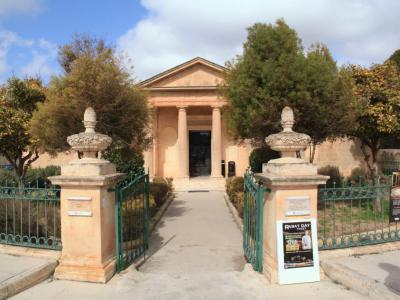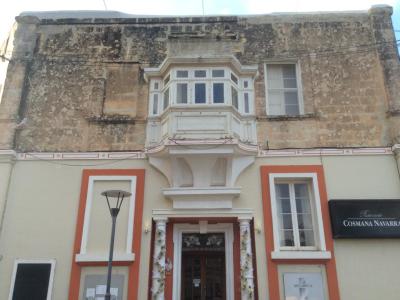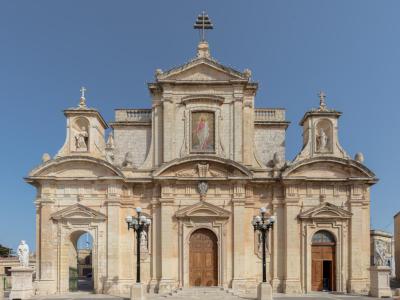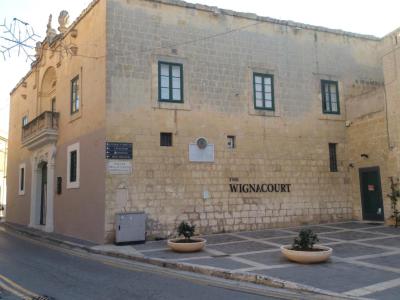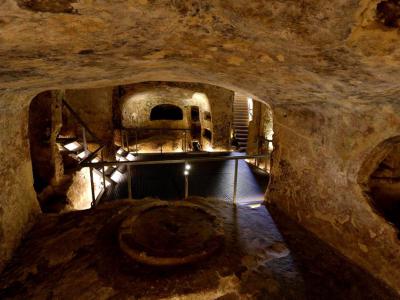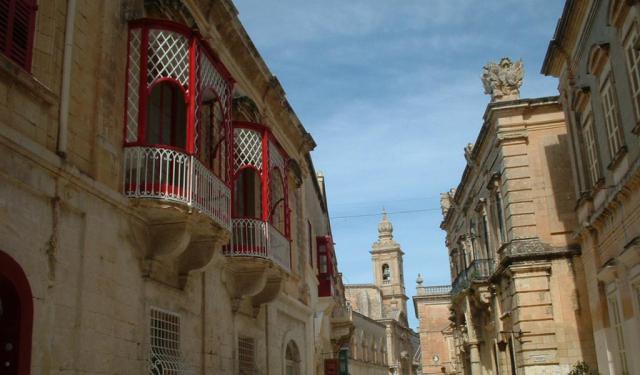Rabat Walking Tour (Self Guided), Mdina
In ancient times, the city of Melite, the precursor of today's Mdina, was much larger than its counterpart. During the Arab occupation of Malta, the city was divided into two smaller towns: Mdina and Rabat.
Rabat's full name, Ribat al-Fath, translates literally to the “Victory Village”. Once considered to be the suburb of Mdina, this quiet neighborhood is located practically on its doorstep and is known for its more rural character.
Despite its small size, Rabat is definitely worth a visit and is home to some impressive archaeological remains that hold great historical and cultural value.
The Domus Romana, or Roman Villa Museum, showcases the Roman townhouse dating back to the 1st century BC.
Cosmana Navarra House is another gem in Rabat's crown. This historic house is a testament to Maltese architecture and offers a glimpse into the life of a noble family in the 17th century.
The Basilica of Saint Paul is a spiritual sanctuary that dominates Rabat's skyline. This impressive church boasts beautiful architecture and artwork that tells the story of Malta's religious scene.
For those with an appetite for history and art, a visit to the Wignacourt Museum housed in a grand 17th-century palace is highly recommended.
Delving deeper into Rabat's history, one shouldn't miss the Catacombs of Saint Paul. This remarkable underground complex, carved into the soft limestone, served as a burial site during Roman times and later as early Christian catacombs.
As a town resonating with history and culture, Rabat may be an ideal destination for those looking for a quieter trip. So, if you are, plan your visit to Rabat today and embark on this self-guided walk through the annals of history.
Rabat's full name, Ribat al-Fath, translates literally to the “Victory Village”. Once considered to be the suburb of Mdina, this quiet neighborhood is located practically on its doorstep and is known for its more rural character.
Despite its small size, Rabat is definitely worth a visit and is home to some impressive archaeological remains that hold great historical and cultural value.
The Domus Romana, or Roman Villa Museum, showcases the Roman townhouse dating back to the 1st century BC.
Cosmana Navarra House is another gem in Rabat's crown. This historic house is a testament to Maltese architecture and offers a glimpse into the life of a noble family in the 17th century.
The Basilica of Saint Paul is a spiritual sanctuary that dominates Rabat's skyline. This impressive church boasts beautiful architecture and artwork that tells the story of Malta's religious scene.
For those with an appetite for history and art, a visit to the Wignacourt Museum housed in a grand 17th-century palace is highly recommended.
Delving deeper into Rabat's history, one shouldn't miss the Catacombs of Saint Paul. This remarkable underground complex, carved into the soft limestone, served as a burial site during Roman times and later as early Christian catacombs.
As a town resonating with history and culture, Rabat may be an ideal destination for those looking for a quieter trip. So, if you are, plan your visit to Rabat today and embark on this self-guided walk through the annals of history.
How it works: Download the app "GPSmyCity: Walks in 1K+ Cities" from Apple App Store or Google Play Store to your mobile phone or tablet. The app turns your mobile device into a personal tour guide and its built-in GPS navigation functions guide you from one tour stop to next. The app works offline, so no data plan is needed when traveling abroad.
Rabat Walking Tour Map
Guide Name: Rabat Walking Tour
Guide Location: Malta » Mdina (See other walking tours in Mdina)
Guide Type: Self-guided Walking Tour (Sightseeing)
# of Attractions: 5
Tour Duration: 1 Hour(s)
Travel Distance: 0.6 Km or 0.4 Miles
Author: DanaOffice
Sight(s) Featured in This Guide:
Guide Location: Malta » Mdina (See other walking tours in Mdina)
Guide Type: Self-guided Walking Tour (Sightseeing)
# of Attractions: 5
Tour Duration: 1 Hour(s)
Travel Distance: 0.6 Km or 0.4 Miles
Author: DanaOffice
Sight(s) Featured in This Guide:
- Domus Romana (Roman Villa Museum)
- Cosmana Navarra House
- Basilica of St. Paul
- Wignacourt Museum
- Catacombs of St. Paul
1) Domus Romana (Roman Villa Museum)
The Villa stands as an architectural gem and a pivotal historical site not only within Rabat but across the entire island of Malta. Dating back to the 1st century BC, this remarkable Roman building's existence remained hidden until its archaeological discovery in 1881. Today, it serves as an invaluable museum, thoughtfully constructed atop the ancient ruins to ensure the preservation of its profound historical treasures.
Visitors to the Villa are treated to a captivating tour that offers a glimpse into the past. As one walks through its hallowed halls, the most striking feature is undoubtedly the intricate mosaics that adorn the entirety of the floor. These mosaics are not merely decorative; they are a testament to the artistry and craftsmanship of the Roman era, providing a vivid and tangible link to the past.
Beyond the awe-inspiring mosaics, the museum houses a treasure trove of artifacts that once belonged to the inhabitants of the Domus Romana. These artifacts offer a window into the customs and lifestyles of Roman families, shedding light on their education, fashion, culinary preferences, and much more. Visitors are invited to embark on a journey through time, immersing themselves in the daily lives of these ancient Maltese inhabitants.
The construction of the Domus Romana museum serves a dual purpose: to protect and showcase the invaluable archaeological finds. It not only preserves the mosaics and artifacts but also acts as a bridge between the modern world and the rich history of Rabat, Malta. As a visitor, you will have the opportunity to engage with the captivating history and traditions of this region.
Visitors to the Villa are treated to a captivating tour that offers a glimpse into the past. As one walks through its hallowed halls, the most striking feature is undoubtedly the intricate mosaics that adorn the entirety of the floor. These mosaics are not merely decorative; they are a testament to the artistry and craftsmanship of the Roman era, providing a vivid and tangible link to the past.
Beyond the awe-inspiring mosaics, the museum houses a treasure trove of artifacts that once belonged to the inhabitants of the Domus Romana. These artifacts offer a window into the customs and lifestyles of Roman families, shedding light on their education, fashion, culinary preferences, and much more. Visitors are invited to embark on a journey through time, immersing themselves in the daily lives of these ancient Maltese inhabitants.
The construction of the Domus Romana museum serves a dual purpose: to protect and showcase the invaluable archaeological finds. It not only preserves the mosaics and artifacts but also acts as a bridge between the modern world and the rich history of Rabat, Malta. As a visitor, you will have the opportunity to engage with the captivating history and traditions of this region.
2) Cosmana Navarra House
Cosmana Navarra House, a 17th-century aristocratic townhouse nestled in Rabat stands as a testament to both architectural elegance and the enduring spirit of its namesake, Cosmana Navarra.
Cosmana Navarra, born Guzmana Cumbo and later known by her mother's surname as Navarra, was the daughter of Gakbu Cumbo and Cornelia Cumbo (born Navarra), hailing from the illustrious Cumbo-Navarra family. Her life took a significant turn when, at the age of 25, she entered into a lifelong union with Lorenzo Cassar in the Cathedral of Imdina on June 22, 1625. Although their marriage was childless, it granted Cosmana Navarra the opportunity to dedicate her time and resources to the construction of her house and the restoration of the parish church in Rabat.
Devotion to St. Paul was a cornerstone of Cosmana Navarra's life, and her actions reflected this unwavering commitment. Her endeavors played a pivotal role in shaping the St. Paul pilgrimage site in Rabat, specifically St. Paul's Cave (Grotto), now part of the Wignacourt Museum. Her philanthropic efforts extended to the reconstruction of the parish church, which aimed to accommodate pilgrims from across Europe, marking a significant milestone in the development of tourism in Malta.
Casa Cosmana Navarra is a notable presence in Rabat's architectural landscape. In the 17th century, it was a rare example of a residential house constructed outside fortified cities like Mdina. The building itself exudes the charm of traditional Maltese townhouses. Its façade, characterized by a closed timber balcony and two neoclassical columns, adds a touch of modernity that was uncommon for its time.
Today, Casa Cosmana Navarra has been repurposed into a restaurant, welcoming the public to savor not only its culinary offerings but also the historical ambiance that permeates its walls.
Cosmana Navarra, born Guzmana Cumbo and later known by her mother's surname as Navarra, was the daughter of Gakbu Cumbo and Cornelia Cumbo (born Navarra), hailing from the illustrious Cumbo-Navarra family. Her life took a significant turn when, at the age of 25, she entered into a lifelong union with Lorenzo Cassar in the Cathedral of Imdina on June 22, 1625. Although their marriage was childless, it granted Cosmana Navarra the opportunity to dedicate her time and resources to the construction of her house and the restoration of the parish church in Rabat.
Devotion to St. Paul was a cornerstone of Cosmana Navarra's life, and her actions reflected this unwavering commitment. Her endeavors played a pivotal role in shaping the St. Paul pilgrimage site in Rabat, specifically St. Paul's Cave (Grotto), now part of the Wignacourt Museum. Her philanthropic efforts extended to the reconstruction of the parish church, which aimed to accommodate pilgrims from across Europe, marking a significant milestone in the development of tourism in Malta.
Casa Cosmana Navarra is a notable presence in Rabat's architectural landscape. In the 17th century, it was a rare example of a residential house constructed outside fortified cities like Mdina. The building itself exudes the charm of traditional Maltese townhouses. Its façade, characterized by a closed timber balcony and two neoclassical columns, adds a touch of modernity that was uncommon for its time.
Today, Casa Cosmana Navarra has been repurposed into a restaurant, welcoming the public to savor not only its culinary offerings but also the historical ambiance that permeates its walls.
3) Basilica of St. Paul
The Basilica of Saint Paul in Rabat, stands as a historical and religious treasure deeply entwined with the rich tapestry of Maltese history. This venerable church is situated on a site that has witnessed centuries of transformation, beginning with its origins in the ancient Roman city of Melite, which encompassed the present-day areas of Mdina and much of Rabat.
It is worth noting that several churches preceded the current basilica, which itself was constructed in the 17th century. In 1336, Bishop Hilarius referred to the church as "ecclesia Sancti Pauli de crypta," acknowledging its existence and the presence of a cemetery and the remnants of a Roman ditch.
The present-day Basilica of Saint Paul was commissioned to replace a previous church completed in 1578. This ambitious endeavor was made possible through the generous contributions of Guzmana Navarra, a noblewoman, and was executed based on architectural plans prepared by Francesco Buonamici. Construction commenced in 1653 and reached completion in 1683 under the skilled hands of Lorenzo Gafà.
Adjacent to the Basilica of Saint Paul is a smaller church dedicated to Saint Publius, which underwent renovations in 1692 and later in 1726 under the supervision of Salvu Borg. The historical significance of this religious complex is further underscored by its elevation to the status of a Minor Basilica in 2020.
The heart of the Basilica of Saint Paul lies in its grotto, accessible through the adjoining church of Saint Publius. This sacred space holds profound significance, as it is traditionally believed to be where Saint Paul resided and preached during his three-month stay in Malta in 60 A.D. In 1748, Grand Master Pinto donated a statue of Saint Paul to the grotto, further enhancing its sanctity. The grotto has received visits from various Popes, including Pope John Paul II in 1990 and 2001, Pope Benedict XVI in 2010, and most recently, Pope Francis during his apostolic journey to the Maltese islands in April 2022.
It is worth noting that several churches preceded the current basilica, which itself was constructed in the 17th century. In 1336, Bishop Hilarius referred to the church as "ecclesia Sancti Pauli de crypta," acknowledging its existence and the presence of a cemetery and the remnants of a Roman ditch.
The present-day Basilica of Saint Paul was commissioned to replace a previous church completed in 1578. This ambitious endeavor was made possible through the generous contributions of Guzmana Navarra, a noblewoman, and was executed based on architectural plans prepared by Francesco Buonamici. Construction commenced in 1653 and reached completion in 1683 under the skilled hands of Lorenzo Gafà.
Adjacent to the Basilica of Saint Paul is a smaller church dedicated to Saint Publius, which underwent renovations in 1692 and later in 1726 under the supervision of Salvu Borg. The historical significance of this religious complex is further underscored by its elevation to the status of a Minor Basilica in 2020.
The heart of the Basilica of Saint Paul lies in its grotto, accessible through the adjoining church of Saint Publius. This sacred space holds profound significance, as it is traditionally believed to be where Saint Paul resided and preached during his three-month stay in Malta in 60 A.D. In 1748, Grand Master Pinto donated a statue of Saint Paul to the grotto, further enhancing its sanctity. The grotto has received visits from various Popes, including Pope John Paul II in 1990 and 2001, Pope Benedict XVI in 2010, and most recently, Pope Francis during his apostolic journey to the Maltese islands in April 2022.
4) Wignacourt Museum
The Wignacourt Museum is a cultural gem nestled within an exquisite 18th-century Baroque building with a rich historical legacy. The building's history is intertwined with the Chaplains of the Order of St. John, and it bears the name of Grand Master Alof de Wignacourt, who governed the Maltese Islands from 1601 to 1622.
The museum's significance extends beyond its architectural splendor; it is intricately connected to St. Paul's Grotto, a place where the Apostle Paul is believed to have found refuge during his shipwreck in Malta. Additionally, the museum encompasses a network of hypogea, underground chambers, and World War II-era air raid shelters, adding layers of historical depth to its offerings.
The heart of the Wignacourt Museum lies in its extensive collections, primarily focusing on art and religious artifacts. The Baroque building, constructed in 1749, spans three levels, each with its own unique treasures. The underground level serves as a link to St. Paul's Grotto and houses a captivating array of Punic, Roman, and Early Christian hypogea. This underground complex also includes remnants of World War II-era air raid shelters, providing a glimpse into Malta's wartime history.
The building itself boasts a charming garden and a small chapel that once served as a place of private worship for the chaplains. The museum's main floor hosts an art gallery showcasing works by prominent artists such as Mattia Preti, Antoine de Favray, and Francesco Zahra. These paintings offer a visual journey through Malta's artistic heritage.
The museum's diverse collections extend beyond paintings to include sculptures, an altar once used for celebrating Mass on Hospitaller galleys, antique silverware, relics, pottery, coins, maps, rare books, and prints. This comprehensive assortment caters to a wide range of interests, from art enthusiasts to history buffs, allowing visitors to explore Malta's multifaceted past and cultural evolution.
The museum's significance extends beyond its architectural splendor; it is intricately connected to St. Paul's Grotto, a place where the Apostle Paul is believed to have found refuge during his shipwreck in Malta. Additionally, the museum encompasses a network of hypogea, underground chambers, and World War II-era air raid shelters, adding layers of historical depth to its offerings.
The heart of the Wignacourt Museum lies in its extensive collections, primarily focusing on art and religious artifacts. The Baroque building, constructed in 1749, spans three levels, each with its own unique treasures. The underground level serves as a link to St. Paul's Grotto and houses a captivating array of Punic, Roman, and Early Christian hypogea. This underground complex also includes remnants of World War II-era air raid shelters, providing a glimpse into Malta's wartime history.
The building itself boasts a charming garden and a small chapel that once served as a place of private worship for the chaplains. The museum's main floor hosts an art gallery showcasing works by prominent artists such as Mattia Preti, Antoine de Favray, and Francesco Zahra. These paintings offer a visual journey through Malta's artistic heritage.
The museum's diverse collections extend beyond paintings to include sculptures, an altar once used for celebrating Mass on Hospitaller galleys, antique silverware, relics, pottery, coins, maps, rare books, and prints. This comprehensive assortment caters to a wide range of interests, from art enthusiasts to history buffs, allowing visitors to explore Malta's multifaceted past and cultural evolution.
5) Catacombs of St. Paul
The Catacombs of St. Paul are remarkable underground structures with a rich history that traces back to the 3rd century A.D. Located in Rabat, these catacombs offer an intriguing journey into the Christian burial practices of the ancient era, making for an engaging and educational experience.
Visitors to the Catacombs of St. Paul can embark on a captivating four-kilometer tour, during which they can delve into the burial customs prevalent in Rabat during that period. These catacombs are an architectural marvel, featuring a network of underground galleries that have withstood the test of time.
Inside these underground chambers, one can explore approximately 30 hypogea, which are divided into two expansive sections. These hypogea serve as resting places for the deceased and provide valuable insights into the religious and cultural practices of the time.
The name of these catacombs is steeped in legend, adding an extra layer of fascination to the site. According to local lore, it is believed that Saint Paul, the apostle, sought refuge within these catacombs following a shipwreck. This legend adds a sense of historical and spiritual significance to the site, making it all the more intriguing for visitors.
One of the most remarkable aspects of the Catacombs of St. Paul is the exceptional preservation of the tombs and frescoes found within. These ancient burial chambers and their intricate artwork have endured centuries, allowing visitors to witness the craftsmanship and artistry of the past. It's a testament to the dedication and reverence with which these catacombs were constructed and maintained.
It's worth noting that the location of these catacombs on the outskirts of the city is historically significant. In the past, these underground burial sites were considered unhygienic, which led to their placement away from the city center. This historical context provides additional insights into the societal norms and beliefs of the time, further enriching the visitor experience.
Visitors to the Catacombs of St. Paul can embark on a captivating four-kilometer tour, during which they can delve into the burial customs prevalent in Rabat during that period. These catacombs are an architectural marvel, featuring a network of underground galleries that have withstood the test of time.
Inside these underground chambers, one can explore approximately 30 hypogea, which are divided into two expansive sections. These hypogea serve as resting places for the deceased and provide valuable insights into the religious and cultural practices of the time.
The name of these catacombs is steeped in legend, adding an extra layer of fascination to the site. According to local lore, it is believed that Saint Paul, the apostle, sought refuge within these catacombs following a shipwreck. This legend adds a sense of historical and spiritual significance to the site, making it all the more intriguing for visitors.
One of the most remarkable aspects of the Catacombs of St. Paul is the exceptional preservation of the tombs and frescoes found within. These ancient burial chambers and their intricate artwork have endured centuries, allowing visitors to witness the craftsmanship and artistry of the past. It's a testament to the dedication and reverence with which these catacombs were constructed and maintained.
It's worth noting that the location of these catacombs on the outskirts of the city is historically significant. In the past, these underground burial sites were considered unhygienic, which led to their placement away from the city center. This historical context provides additional insights into the societal norms and beliefs of the time, further enriching the visitor experience.
Walking Tours in Mdina, Malta
Create Your Own Walk in Mdina
Creating your own self-guided walk in Mdina is easy and fun. Choose the city attractions that you want to see and a walk route map will be created just for you. You can even set your hotel as the start point of the walk.
Mdina Introduction Walking Tour
A picturesque walled city in the heart of Malta, Mdina is a true gem of the Mediterranean located atop a hill that overlooks most of the country.
Mdina's history spans almost 3,000 years, making it one of Europe's oldest continuously inhabited cities. Originally settled by the Phoenicians in around the 8th century BC, it has been inhabited by various civilizations, including the... view more
Tour Duration: 2 Hour(s)
Travel Distance: 0.8 Km or 0.5 Miles
Mdina's history spans almost 3,000 years, making it one of Europe's oldest continuously inhabited cities. Originally settled by the Phoenicians in around the 8th century BC, it has been inhabited by various civilizations, including the... view more
Tour Duration: 2 Hour(s)
Travel Distance: 0.8 Km or 0.5 Miles
The Most Popular Cities
/ view all



